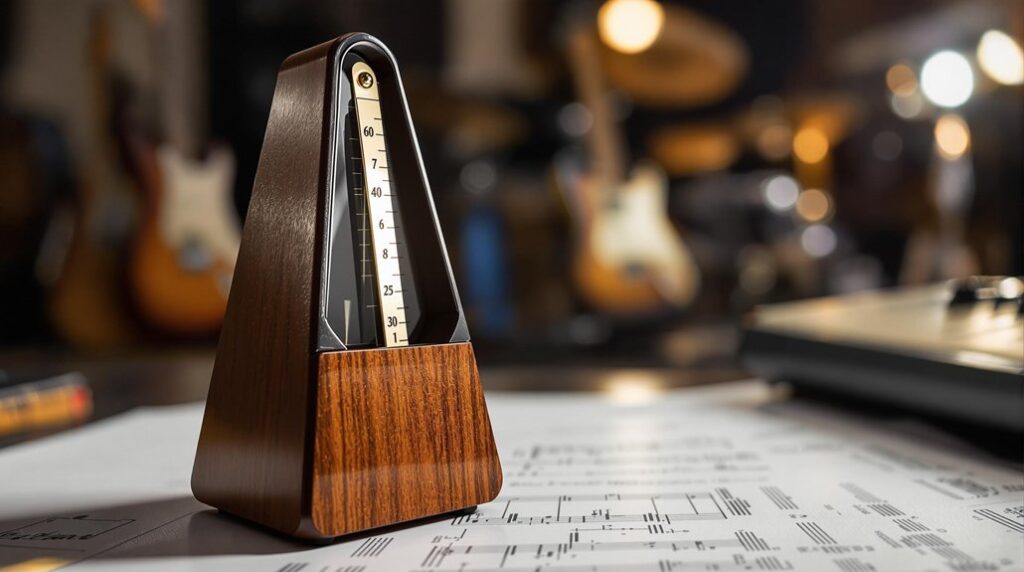Key signatures are essential in defining the tonal framework of musical compositions, with 15 major variants ranging from C major, having no sharps or flats, to B major. The Circle of Fifths provides a detailed visual representation of these key relationships, facilitating understanding of tonal shifts through clockwise sharp additions and counterclockwise flat increments. Mastery involves memorizing sharp and flat orders, aided by mnemonic devices, to quickly identify tonal centers. Proficient recognition of key signatures enhances musicians’ ability to navigate complex compositions effortlessly. For those seeking to deepen their understanding, exploring these foundational concepts is vital.
Key Takeaways
- Key signatures define musical scales, affecting melody and harmony, and are crucial for reading and interpreting sheet music accurately.
- The Circle of Fifths visually maps key relationships and helps musicians understand tonal shifts and key signature progressions.
- Sharps and flats follow specific orders, aiding in the rapid identification and understanding of key signatures.
- The Circle of Fifths helps identify relative minor keys and enharmonic equivalents, expanding harmonic understanding.
- Mastering key signatures and related concepts enhances improvisational skills and musical expression across various genres.
Key Signatures Basics
Key signatures form a fundamental aspect of music theory, serving as an essential guide for musicians to understand the tonal framework of a composition.
Key signatures basics involve recognizing the presence of sharps or flats, vital for delineating the tonal center of a piece. There are 15 major key signatures, with C major uniquely having neither sharps nor flats.
Each key signature determines the scale utilized, influencing melodic and harmonic structures. The Circle of Fifths is an invaluable visual tool, mapping out key relationships and facilitating quick identification of tonal shifts.
Mastery of key signatures enhances a musician’s ability to read music accurately and supports improvisation by establishing a clear understanding of the underlying tonal foundation. Additionally, understanding key changes can create tension and release in music, enhancing the emotional arc of a song.
Sharps and Flats Order
Understanding the foundational concepts of key signatures naturally leads to an exploration of the systematic order of sharps and flats within those signatures.
The order of sharps—F, C, G, D, A, E, B—is pivotal for accurately identifying and constructing sharp key signatures. Mnemonics such as “Fast Cars Go Dangerously Around Every Bend” facilitate memorization.
Conversely, flat key signatures adhere to the sequence B, E, A, D, G, C, F. The mnemonic “BEAD, GCF” or “Father Charles Goes Down And Ends Battle” aids in recalling this order.
Grasping the sharps and flats order is essential for musicians to adeptly navigate key signatures, ensuring fluidity and precision in both composition and performance. This knowledge underpins effective musical literacy. Additionally, understanding chord progressions can significantly enhance how musicians apply these key signatures in their compositions.
How does the Circle of Fifths serve as an essential tool for musicians in understanding key relationships? This analytical framework visually delineates the progression of key signatures, effectively mapping out tonal shifts.
Clockwise movement from C major introduces successive sharps, advancing through G major, D major, and so forth, culminating in B major with five sharps. Conversely, counterclockwise navigation adds flats, with F major introducing one flat, proceeding to B♭ major and E♭ major, reaching C♭ major with seven flats.
The Circle of Fifths also reveals relative minor keys, located three steps counterclockwise, thereby enhancing a musician’s ability to modulate seamlessly. Additionally, it highlights enharmonic equivalence, as seen in B major and C♭ major, facilitating smoother passages across complex compositions. Understanding the Camelot Wheel can further aid in identifying harmonically compatible tracks for seamless DJ mixing.
Identifying Key Signatures Quickly
In the domain of music theory, efficient key signature identification is paramount for both performers and composers.
Sharp key signatures can be quickly determined by ascending a half step from the last sharp present, while flat key signatures require identifying the second-to-last flat to ascertain the key.
Mastery of these methods, coupled with the memorization of the respective sequences of sharps and flats, facilitates rapid recognition and enhances overall musical proficiency. Additionally, understanding time signatures is essential as they provide a framework for rhythmic execution in performances.
Sharp Key Signature Method
When attempting to quickly identify sharp key signatures, the methodology involves discerning the last sharp in the sequence and raising a half step to determine the corresponding key name. This approach is rooted in the structured order of sharps: F, C, G, D, A, E, and B.
The mnemonic “Fast Cars Go Dangerously Around Every Bend” aids in memorizing this sequence. Each added sharp raises a specific pitch by a half step, modifying the music’s tonality.
For instance, if C♯ is the terminal sharp, the key is D major or B minor, as D is a half step above C♯. Mastery of this method enhances musicians’ ability to accurately interpret sharp key signatures, thereby facilitating precise and efficient music performance.
Flat Key Signature Tips
Building on the understanding of sharp key signatures, it is equally important to grasp the methodology for identifying flat key signatures efficiently. A systematic approach involves recognizing the second-to-last flat in the sequence as the key’s identifier; for instance, with three flats, E♭ major is the key.
The order of flats—B, E, A, D, G, C, F—provides a structured framework for memorization and quick identification. This orderly sequence prevents excessive notation of accidentals, facilitating smoother music reading and performance.
Mastery of flat key signatures is essential for musicians, enhancing interpretative skills and overall proficiency. Employing the mnemonic “BEAD, GCF” further aids in swift recall, ensuring musicians can accurately engage with various musical compositions.
Efficient Key Identification
Efficient key identification is a fundamental skill for musicians, enhancing both their technical proficiency and interpretative insight. In Music Theory, identifying key signatures rapidly is essential for performance and composition.
For sharp key signatures, locate the last sharp and ascend a half step; for instance, F♯ indicates G major. Conversely, flat key signatures are determined by the second-to-last flat, such as A♭ indicating E♭ major.
Memorizing the order of sharps (F, C, G, D, A, E, B) and flats (B, E, A, D, G, C, F) streamlines this process. The Circle of Fifths serves as a visual tool, elucidating the interconnections of key signatures.
Mastering these techniques enables musicians to enhance their improvisational skills and technical agility effectively.
Key Signatures in Practice
Although often perceived as a mere theoretical construct, key signatures hold practical significance in music performance and composition, acting as a foundational element that guides musicians through the intricate expanse of tonal music.
In practice, key signatures convey essential information regarding the number of sharps or flats, facilitating accurate music reading and performance. Musicians employ key signatures to identify tonal centers, enhancing improvisational capabilities by understanding the emotional nuances of a piece.
The Circle of Fifths is instrumental in this regard, visually representing the progression between sharp and flat signatures and their interrelationships. Understanding key relationships is vital for navigating complex compositions effectively.
For composers, mastery of key signatures is indispensable, allowing for the precise communication of musical ideas. Consequently, comprehension of key signatures in practice is crucial for seamless navigation of diverse musical environments.
Understanding Music Notation
Within the field of music theory, understanding notation is pivotal for both performers and composers as it serves as the primary language of musical communication.
Music notation is systematically structured on a staff comprising five lines and four spaces where notes, labeled A through G, are positioned to denote pitch and duration. The clef, such as treble or bass, is essential for defining the pitch range, guiding musicians in interpreting the correct notes.
Additionally, key signatures using various symbols are integrated to indicate the tonal center and accidentals within a piece. This thorough system, encompassing notes and rhythms, is integral for reading and interpreting musical scores accurately, thereby forming the foundation of effective musical performance and composition. Furthermore, a clear understanding of note durations is crucial for mastering rhythm and pacing in music.
Rhythm and Measures Essentials
Rhythm serves as the backbone of musical expression, providing structure and order to compositions through the calculated placement of sounds and silences.
Rhythmic symbols, such as the quarter note, are essential in defining the duration of each sound. A quarter note, lasting one beat, is fundamental in many time signatures, particularly 3/4, where it acts as the standard unit of measure.
Rests, including the quarter rest, mirror these durations in silence, ensuring balance between sound and silence.
Bar lines strategically divide music into measures, reinforcing the rhythmic framework and aiding performers in interpreting the piece’s structure.
Time signatures dictate the number of beats per measure, underscoring the importance of mastering rhythm for precise timing and synchronization in musical performances. Understanding time signatures is crucial for creating cohesive musical pieces that resonate with listeners.
Jazz Improvisation and Theory
In the field of jazz improvisation, a profound understanding of music theory serves as a pivotal foundation for developing one’s artistic voice. Transcribing solos from Jazz Masters is central to mastering intricate note choices within chord structures. Key concepts such as Major, Minor, and Pentatonic scales, alongside chord progressions, are instrumental in constructing effective jazz solos. Mastery of the ii-V7 progression is indispensable for improvisers to navigate chord changes with finesse. Resources like audio files, scale sheets, and backing tracks enhance the practical application of jazz theory, fostering a deeper comprehension of stylistic nuances. Below is a concise guide to essential elements in jazz improvisation:
| Concept | Importance |
|---|---|
| Transcription | Develops note choice understanding |
| Major Scale | Fundamental for solo construction |
| Minor Scale | Adds emotional depth |
| Pentatonic Scale | Versatile for melodic creation |
| ii-V7 Progression | Essential for smooth chord navigation |
In addition to these elements, understanding mixing techniques can further elevate the quality of your jazz performances.
Core Music Theory Concepts
Music theory serves as the backbone of musical understanding, providing a structured framework for analyzing and creating music. At its core, major and minor scales establish a tonal foundation through specific patterns of whole and half steps, which are further delineated by key signatures.
These key signatures are systematically organized via the Circle of 4ths and 5ths, illuminating the intricate relationships between scales and their respective sharps or flats.
Further complexity is introduced through various chord types, such as triads and 7th chords, constructed from precise intervals that facilitate harmonic analysis.
The ii-V7 progression plays a pivotal role in jazz, offering seamless shifts between chords. Additionally, modes derived from the major scale enrich the harmonic palette, providing diverse emotional qualities for improvisation and composition. Understanding chord progressions is essential for crafting compelling musical narratives.
Frequently Asked Questions
What Are the 12 Key Signatures?
The 12 key signatures in Western music comprise 7 major and 5 minor keys, each with distinct key characteristics. Major keys include C, G, D, A, E, B, F♯, while minor keys encompass A, E, B, F♯, C♯.
What Is the Rule for Reading Key Signatures?
The rule for reading key signatures involves discerning key relationships through patterns. Sharps: identify the key by noting the last sharp and ascending a half step. Flats: determine the key via the second-to-last flat. Utilize mnemonic devices for order recall.
Do You Need to Know How Do You Read Music for Music Theory?
Understanding music fundamentals is essential for comprehending music theory. Proficiency in reading music notation, including pitches and key signatures, forms the basis for analyzing rhythm, structure, and harmony, thereby enabling advanced theoretical exploration and musicianship skills development.
What Is the Mnemonic for Key Signatures?
Mnemonic devices for key signatures include “Fast Cars Go Dangerously Around Every Bend” for sharps and “BEAD, GCF” or “Father Charles Goes Down And Ends Battle” for flats. These tools facilitate efficient music theory comprehension and key signature identification.
Conclusion
The exploration of key signatures and their foundational elements such as sharps and flats order, alongside the circle of fifths, offers an essential framework for understanding music theory. Rapid identification of key signatures and their practical application in music notation enhances theoretical comprehension. Integrating rhythm and measure essentials further enriches musical interpretation. Jazz improvisation exemplifies the dynamic use of these concepts, underscoring their relevance. Mastery of these core music theory elements is vital for advanced musical analysis and performance.




